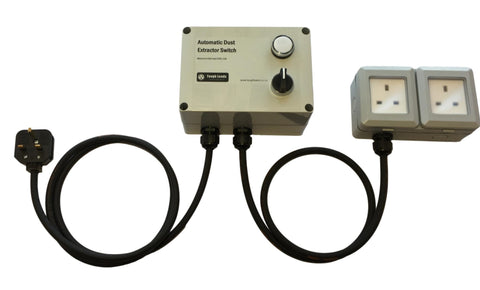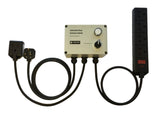Our dust extractor automatic switch is in a different league to the other 'hobby' units which are available. Built from high quality industrial specification components, in an incredibly robust enclosure, it is designed for heavy professional use.
The unit is compatible with extractors which have a simple on/off switch or NVR. Where fitted, an NVR (start/stop switch) must be bypassed for the remote control to work. Otherwise, each time the remote turns on the supply, the start button on the tool would have to be pressed. Further guidance can be found here.

See our guide to dust extractor remote and automatic controls for further information.
Simply plug the unit into a 230v 13A socket, and then connect the vacuum/dust extractor to the single socket and power tools to the 2 or 4 gang socket. The sockets can be mounted above a workbench, enabling multiple tools to control one extractor. When any of the power tools is turned on, the extractor will start. When the last tool is turned off, the extractor will stop after the set off delay (adjustable, supplied set to 10 seconds).

Our extractor controls are the only ones on the market which use an industrial contactor instead of a relay to switch the extractor. Other units use a relay, which is a cheap, compact and great way of controlling resistive loads. The issue is that any power tool with a motor creates an inductive load (further explanation of load types can be found here). When the relay contacts open to turn the tool off, the stored inductive energy in the motor coil is discharged, resulting in a damaging arc across the terminals, which can eventually cause the relay to fail. We use a high quality contactor instead of a relay. Contactors work using the same principle, but they are much larger and far better suited to switching higher current inductive loads. The picture below shows the sheer size difference between a typical contactor (left) and relay (right); when it comes to switching inductive loads, contact size really does make a difference.

Socket options:
- Combined vacuum (left) and power tool (right) double socket.
- Separate single socket for the vacuum, and 4 gang socket for the power tools, with an option of 1m and 5m lengths.
Specification:
- Extremely robust IP66 rated enclosure, dimensions L175mm x W125mm x D100mm.
- Rotary switch to enable dust extractor to be set to off, on or automatic. The switch was chosen to be easy to use when wearing gloves.
- 16mm blue indicator shows when the extractor is on.
- Extractor is powered for approximately 10 seconds after the power tool has turned off, in order to clear the vacuum tubing. The delay can be manually altered by the user, although this requires removal of the cover.
- Contractor rating 230v AC-7a (resistive) 40A, AC-7b (inductive) 15A.
- Total load of power tools and extractor must not exceed 3000W (13A).
- If a no volt release switch (NVR) is fitted to the extractor, this will need to be bypassed.
- Industrial specification 1.5mmsq H07RN-F rubber cable specifically manufactured for harsh environments. Find out what’s so special about this cable.
- Both the unit and power tool socket may be wall mounted.
- PAT tested.
Advantages of an automated system:
- Reduces dust, improving the workshop environment.
- Supports compliance with HSE requirements.
- Saves power by running the extractor only when needed.
- Saves time.
- Ensuring dust extraction is always powered up when a tool is in use may improve tool performance.
- Reduces noise.
- Reduces heating bills (where extractor vents outside).




